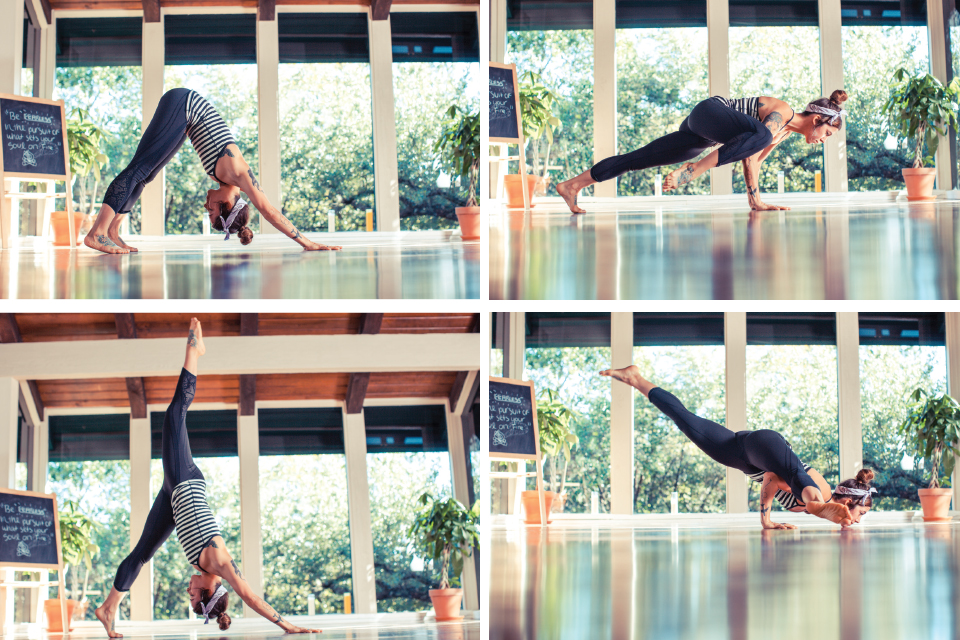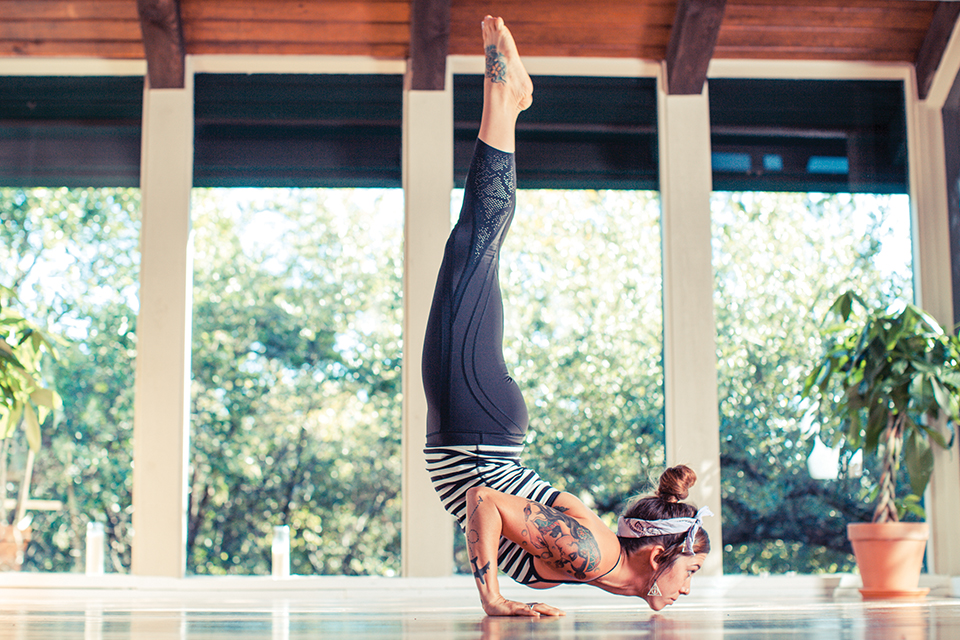Anatomy of a Pose: One Footed Pose

Eka Pada Koundinyasana

The name comes from the Sanskrit words eka meaning “one,” pada meaning “foot,” koundinya for the sage of the same, and “asana” meaning “posture” or “seat.” The asana strengthens the arms, abdominal organs and the thigh muscles. This pose is a very strong pose and can look a little intimidating. With practice in breath and movement this pose can be achieved and also transition quite beautifully into Ganda Bherundasana (also known as “Formidable Face Pose” or “Chin Stand”).
1. Begin in the traditional stance of Downward-Facing Dog. Hands in line with each other and shoulder width apart. Inhale and exhale while in Downward-Facing Dog, peddling into each leg and letting head fall heavy. Once you have gone through a couple of breath cycles, prepare for Step Two.
2. Time for some core and shoulder discipline. I recommend practicing this step several times just to create foundation and strength before entering the actual arm balance. The key here is to keep your gaze forward and be brave enough to lean!
Lift your right leg up into the air from Downward-Facing Dog. Bend your knee as you look forward and bend both elbows toward Chaturanga. Don’t take your shoulders in line with your elbows immediately (this can be very heavy). Try to be be here for two full breaths. Once this feels strong, the right knee will land onto your right tricep and you and continue onto the next step.
3. Once you’ve landed your knee onto your arm as in Step Two, begin to lean into a full Chaturanga. That extra lean forward and down is often all it takes to get the strength and momentum to pick up the back leg. If you have more flexibility, you can straighten out your right leg before the full lean and lift of the back. If you’re less flexible, lean forward with the bent knee and then begin to straighten your front leg once you’re in the arm balance. Draw the bottom tips of your shoulder blades down your back to avoid any collapsing of your shoulder heads. Keep your heart extending forward and tilt your gaze toward your front foot. The left shoulder may be slightly lower than your right. Just keep the shoulders rolling back.
A Sweet Cheat
Eventually this pose is done solely on the front arm, but it’s nice to use your extra arm as a training wheel or just when you’re feeling tired. Let the left side waist rest on your left outer arm to create a shelf. If you feel more stable this way, stick to it!
Transition to Ganda Bherundasana

4. Now here’s the tough part. Transitioning to Chin Stand can take time. However, lots of practice, patience, slow movements and breath make it very possible and easy to achieve. Once you’re in the full version of Eka Pada Koundinyasana, begin to lean your chest forward, bringing your chin slightly to the mat. At the same time you will rebend the right knee and pull the right leg through the center line.
5. This movement will be the quickest of the steps. While your chin is lightly touching the mat and your right knee is bent, you will begin to pull the left leg straight up into the air above you, and at same time pull the right leg through and up.
With strong Chaturanga arms here, your elbows are internally rotating in toward one another, and you will push with all your strength into the earth through the palms of your hands. You will find lift here, and your chin will begin to float about an inch from the ground.
DO
I recommend practicing bringing right knee to right elbow several times just to create foundation and strength before entering the actual arm balance.
DON’T
A bit of advice. Do not go into this pose if most of your weight is in your throat. You should not feel compression in your neck or throat from chin stand. The strength comes through your forearms, shoulders and core. If you feel any compression in the neck and throat, do not move forward into this transition until you have developed the strength in your arms to do this transition without any compression. Take your time with this transition.
Variations
*You may use two blocks. One beneath each palm, and shoulder width apart. That way when you come into the arm balance, you already have lift. This will help you bring the back leg off the mat.
*If you choose to use the blocks, you may also transition into Chin Stand with them. Bring your chest forward as you lower your chin down, and the top of your shoulders can rest on the blocks. This will allow for the less weight to be concentrated in the chin and neck. This is a great variation for students new to these poses.
Advanced
*If you feel solid in Chin Stand after your transition, and you are not using the blocks, you can transition back into Chaturanga by using core strength to hop feet toward the back of your mat. Then you may transition through Vinyasa and end in Downward-Facing Dog where you began.






